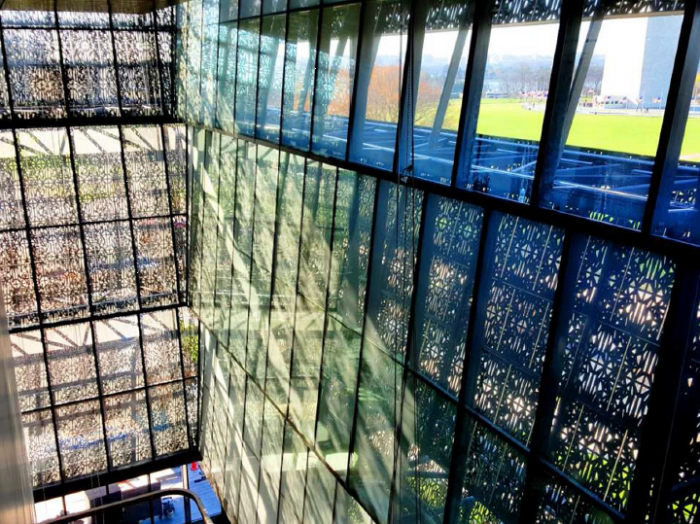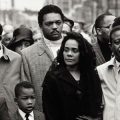A Symbol of Freedom
Even as we celebrate our shared past during Black History Month, we are looking forward to telling the next chapter of the American story with the opening of our newest museum.

For three nights in November 2015, the façade of the Smithsonian’s National Museum of African American history and Culture was illuminated with moving images commemorating three important milestones in African American history: the 150th anniversary of the ratification of the 13th Amendment, the 150th anniversary of the end of the Civil War and the 50th anniversary of the passage of the Voting Rights Act. (Photo taken Nov. 18, 2015)
On a cold evening last November, I attended a heartwarming and truly beautiful and meaningful event, the Commemorate and Celebrate Freedom display outside the National Museum of African American History and Culture. A film called Let the Building Speak was projected onto the bronze-hued exterior of the majestic new building in honor of a trio of historic civil rights milestones: the 150th anniversary of the ratification of the 13th Amendment that ended slavery, the 150th anniversary of the Civil War’s conclusion, and the 50th anniversary of the Voting Rights Act of 1965. The long-awaited building came alive with sound and vision, its accompanying ceremony attended by luminaries and filled with songs, performances and poetry, offering the rapt and cheering crowd a glimpse of the storytelling power that will radiate from within when the building opens to the public later this year.
As we commemorate Black History Month all across the Smithsonian this month, we look forward to the opening of this enormously important new museum and its role in helping us understand and paint a more detailed picture of the American experience, for Americans and for people across the world. It is a picture which is infinitely richer and more vibrant because of the contributions of African Americans to our artistic, cultural, economic, and intellectual identity. The picture is coming into sharper focus with every passing day, as construction is more than 90% finished and on target to open Sept 24.

The Smithsonian’s National Museum of African American History and Culture. (Photo by Michael Barnes)
Many of the finishes in our newest museum at the corner of 14th and Constitution are being finalized now, from carpet to painting to terrazzo flooring. The bronze cladding is being installed on the south porch and a water feature in the south wing is nearly complete. The exhibit floors passed the Indoor Air Quality test, a big milestone in the push to get LEED certification for sustainability. And the high quality of the work done by our contractors has won multiple Craftsmanship Awards from the Washington Building Congress for features including the exterior doors and windows, the electrical lighting systems, and the ornamental metal that gives the museum its distinctive bronze cast.

An interior view of sunlight streaming through the corona panels of the National Museum of African American History and Culture in December 2015.
Several notable objects from the museum’s 33,000-item collection have recently been moved into the building, from the neon sign that adorned the historic Harlem jazz club Minton’s Playhouse, to rock-and-roll legend Chuck Berry’s red Cadillac. They join a Boeing-Stearman PT-13D biplane that was used to train the Tuskegee Airmen, an intact slave cabin from Edisto Island, S.C., a 44-seat segregated Southern Railway passenger car from the 1920s, and other artifacts already in the museum. Smithsonian Regent and philanthropist David Rubenstein, whose $10 million gift to the museum was recently announced, is also loaning the museum copies of the 13th Amendment and the Emancipation Proclamation, each signed by President Lincoln. Many more poignant and thought-provoking artifacts will be displayed, including those from a sunken 200-year-old Portuguese slave ship found off the coast of South Africa. Displaying these culturally important and historically invaluable objects will open eyes, stimulate thought, and encourage examination and dialogue. I cannot wait to learn from the exhibitions, programs and professionals of the museum and to see the faces of parents, students, teachers and learners of all ages when they enter this inspiring new museum.
- This Boeing-Stearman PT-13D Kaydet, c. 1944—used at Alabama’s renowned Tuskegee Institute to train African American pilots for Army air corps service during World War II, is among the collections of the new Natio0nal Museum of African American History and Culture.
- The dismantled Boeing-Stearman PT-13D Kaydet, used to train the famed Tuskeegee airmen awaits reassembly and installation at the National Museum of African American History and Culture. (Photo by Carlos Bustamante)
- Workers prepare to carefully lift the Boeing-Stearman PT-13D Kaydet biplane to its permanent home suspended from the ceiling of the History Gallery, December 2015 (Photo by Carlos Bustamante)
- The historic biplane awaits its unveiling when the National Museum of African American History and Culture opens in September 2016.
The doors are not opened yet, but founding director Lonnie Bunch and his tireless and effective staff and volunteers have been actively engaging the public since the 2012 groundbreaking attended by President Obama, First Lady Michelle Obama, former First Lady Laura Bush, Congressman John Lewis, and many others.
Throughout our museums, libraries, and archives, we examine the African American experience and what its different dimensions have meant to our nation. Some of the ways we are doing that throughout February to celebrate Black History Month include African American Pioneers in Aviation and Space events Feb. 20 at the National Air and Space Museum (NASM) and Feb. 6 at NASM’s Steven F. Udvar-Hazy Center, highlighted by African American pilots sharing their stories about breaking professional and aeronautic barriers. Just Around the Corner: Black America from Civil War to Civil Rights, open Feb. 12, is the National Postal Museum’s first exhibition wholly devoted to African American history. And throughout the month, young visitors to the National Portrait Gallery and their families can listen to stories about esteemed leaders like Langston Hughes, Maya Angelou, and Martin Luther King, Jr. and create accompanying art in the Education Center.
I had the privilege to attend the Anacostia Community Museum’s annual birthday celebration of Martin Luther King, Jr., held Jan. 2016 at the National Museum of Natural History. It was a stirring reminder of Dr. King’s moral courage and steadfast leadership as he inspired so many to dream of a society unshackled from the oppressive weight of prejudice and hatred. As an Institution created to preserve and promote the nation’s heritage, we chronicle Dr. King’s story, as well as those who paved the way for him and those who have taken up his mantle in the struggle to bend the moral arc toward justice.

This photograph shows Martin Luther King Jr. (1929–1968) greeting supporters in Baltimore after he won the Nobel Peace Prize in 1964. (Martin Luther King Jr. by Leonard Freed, gelatin silver print, 1964. National Portrait Gallery, Smithsonian Institution)
With the opening of the National Museum of African American History and Culture Sept. 24, the Smithsonian will be able to more fully explore the epic and complex legacy of the African American experience. As Lonnie Bunch told 60 Minutes, “It is the museum that says, ‘Here is a balanced history of America that allows us to cry and smile.’” This museum will tell the full range of unvarnished stories—struggles, failures, tragedies and triumphs—that are integral fibers in the American tapestry. These stories tell us all who we are. They are more than the African American experience. They are the American experience. The opening of this museum will be one of the proudest moments in the Smithsonian’s history and, indeed, in the history of the nation.
For more information on Smithsonian programs and exhibitions for Black History Month and other Heritage Month celebrations, please visit www.smithsonianeducation.org/heritage_month/.
Posted: 29 January 2016












